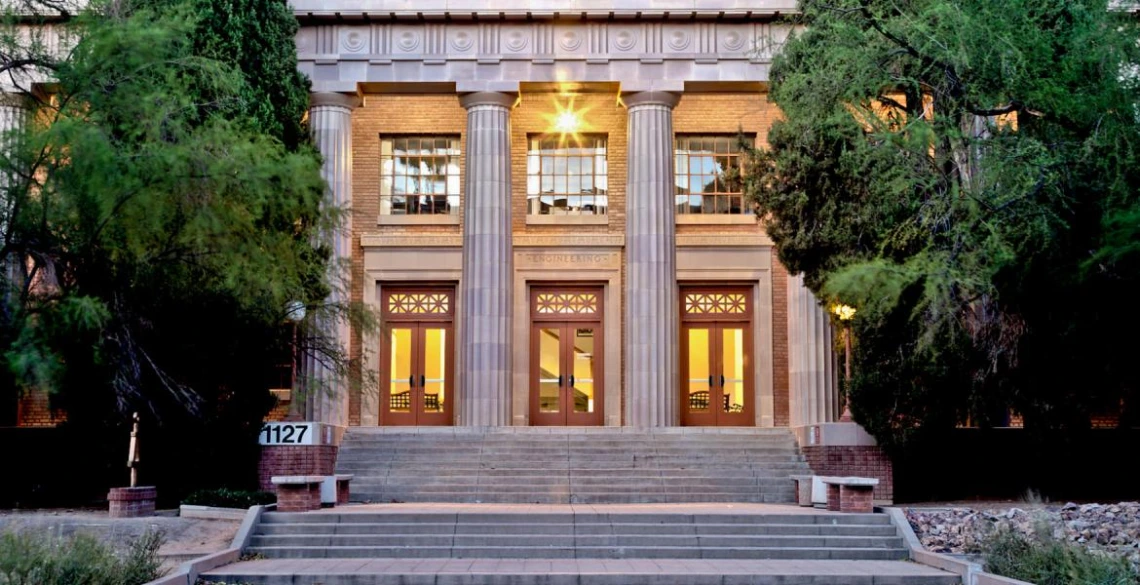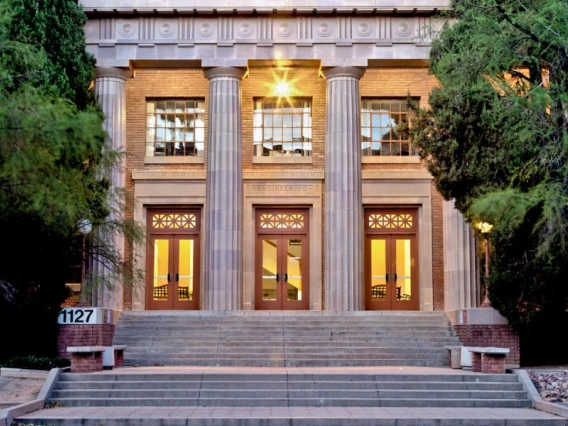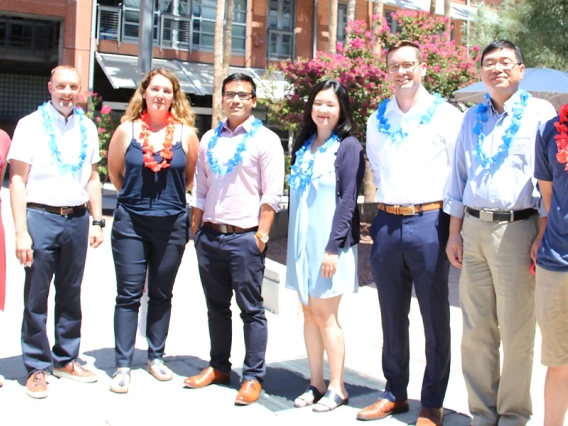College Welcomes 11 New Faculty in 2021-2022
UA Engineering recruits one of the largest and most diverse classes of faculty in its history.

No description provided
The College of Engineering is welcoming 11 new faculty members in the 2021-2022 academic year. Their areas of expertise range from artificial organs and cyber-physical systems to transportation. The college also has hired a department head, the inaugural Patrick R. Taylor Endowed Department Leadership Chair in Materials Science and Engineering. This is the largest, most diverse class of new faculty in 20 years.
One thing they all have in common is that they are advancing technology for a smarter, better world – from at-home health care devices and tools for mining sustainability to otherworldly inventions for space exploration.
“These new hires, and others to follow, go a long way toward demonstrating the power of diversity. They strengthen the college’s position as a global leader in technology and a driving force for the economy and societal improvement,” said David W. Hahn, Craig M. Berge Dean of the College of Engineering.
Angelina Anani
Associate Professor in Mining and Geological Engineering
Making Mining Safe and Sustainable
Anani earned her PhD in mining engineering from Missouri S&T in 2016 and went on to work there as a postdoctoral fellow and lecturer. Since 2017, she has been an assistant professor at the Pontifical Catholic University of Chile, in mining engineering as well as engineering and construction management.
She researches mine system optimization and the development of tools for sustainable decision making. This includes using operations research and artificial intelligence in mine design, safety and production scheduling.
“I am looking forward to being an integral part of the growth of the mining program as well as working with the diverse community at the UA, both in MGE and other departments” she said.
Kavan Hazeli
Associate Professor in Aerospace and Mechanical Engineering
Producing Mechanical Components for Flight and Health Care
Hazeli earned a PhD in mechanical engineering and mechanics at Drexel University in 2014, then completed a postdoctoral fellowship at Johns Hopkins University in 2016.
His research focuses on designing, testing and optimizing mechanical properties of engineering materials, particularly for advanced manufacturing. Applications for his work include hypersonic flight, space exploration and biomedical implants. Additionally, he is creating educational toolkits for teaching engineering concepts to students who are visually impaired or deaf.
“The University of Arizona is a respected name in several social sciences and engineering disciplines,” he said. “Indeed, it is an honor to be part of this family. Moreover, I really like the provost and dean's strategic College of the Engineering growth plan. Their visionary and ambitious plan satisfies my passionate personality.”
Hee-Jeong Kim
Assistant Professor in Civil and Architectural Engineering and Engineering Mechanics
Constructing Durable Structures, on Earth and Beyond
Kim received her PhD in civil and environmental engineering from the Korea Advanced Institute of Science and Technology in 2018, then completed a postdoctoral research position at MIT.
She researches cement hydration mechanisms, ultimately for construction materials of the future. For example, understanding more about cement hydration can better inform development of sustainable and carbon-neutral construction materials, or materials that recycle industrial byproducts. Kim also is interested in developing space cement or ways to build durable structures in space. She was drawn to the UA‘s focus on the Fourth Industrial Revolution and its reputation for working on NASA projects.
“It is a perfect place for conducting innovative research that combines sustainable technology, nanotechnology, robot technology, and information and communication technology for future large-scale construction,” she said. “Also, faculty members at the University of Arizona are intensely engaged in the industry. I think it is an excellent opportunity for me to accelerate research to solve real-world problems.”
Marat Latypov
Assistant Professor in Materials Science and Engineering and the Graduate Program in Applied Mathematics
Developing Materials for Smart Manufacturing
Latypov earned a PhD in materials science and engineering in 2014 from Pohang University of Science and Technology in South Korea. He conducted postdoctoral research at the Georgia Tech/CNRS Laboratory in Metz, France and at the University of California, Santa Barbara. Most recently, he spent two years in research and development at Novelis, an international company specializing in rolling and recycling aluminum.
He is creating digital solutions – involving artificial intelligence, materials physics and data sciences – for sustainable manufacturing.
“The spirit of interdisciplinary research and education fostered by the university is the factor that attracted me most to this position,” he said. “I am impressed by the vision of the leadership team of College of Engineering for significant expansion in the coming years, and I look forward to being part of this growth.”
Hossein Rastgoftar
Assistant Professor in Aerospace and Mechanical Engineering
Managing Uncrewed Aircraft Traffic
Rastgoftar earned a PhD in mechanical engineering in 2015 from Drexel University. Since then, he has worked as a postdoctoral researcher, research faculty member and adjunct professor at the University of Michigan, Ann Arbor, as well as an assistant professor at Villanova University.
His work centers on cyber-physical system optimization and decision making under uncertainty, specifically for managing uncrewed aircraft traffic. Since July 2021, when he started at the UA, he has published five journal papers, including one that details a new model for analyzing the spread of the pandemic in the United States.
“The University of Arizona is a top-tier research university, and it’s a great location for doing research in the aerospace area,” he said.
Alyssa Ryan
Assistant Professor in Civil and Architectural Engineering and Engineering Mechanics
Improving Transportation Systems for Cyclists and Pedestrians
Ryan earned her PhD in civil engineering from the University of Massachusetts, Amherst, then spent 2020-2021 as a visiting scholar at Technical University of Munich.
She investigates smart technologies to make transportation systems safe and equitable for cyclists and pedestrians. Her work extends to smart cities and sustainable transportation.
“I really wanted to work at an institution where students were at the center, but which also does groundbreaking research,” she said. “The UA being a Hispanic-Serving Institution is incredible, and the opportunity to work with first-generation students, who I know make up a larger percentage of students at UA, is exciting.”
Alejandro Salado
Associate Professor of Systems Engineering
Modeling Space and Nautical Systems
Salado earned a PhD in systems engineering in 2014 from the Stevens Institute of Technology, while also designing space systems in industry. He has worked as an assistant professor of systems engineering at Virginia Tech since 2015.
Model-based approaches are an essential part of his work with large-scale systems. His theories apply to all kinds of systems, from airplanes and satellites to submarines. He was interested in the rich history of the Systems and Industrial Engineering Department as well as the college’s Craig M. Berge Engineering Design Program and new BS in software engineering.
“I was also drawn to the vision that the SIE department has for the systems engineering program, and the opportunities for systems engineering that the large NASA missions at the university can offer to faculty and students,” he said.
Shang Song
Assistant Professor in Biomedical Engineering
Implanting Artificial Organs
Song earned her PhD in bioengineering jointly through the University of California, Berkeley, and UC San Francisco. She continued her work in manipulating stem cell functions for tissue regeneration and translational medicine during a postdoctoral research position in neurology and neurological sciences at Stanford University.
She has worked on implantable artificial organs, such as a pancreas to treat Type 1 diabetes and a device that mimics biological organs for drug screening. Columbia University named Song one of its 20 inaugural Rising Stars in Engineering in 2020, and Forbes selected her as a 30 Under 30 in Health Care.
“I'm excited and encouraged by the vision and potential possibilities presented by the Biomedical Engineering Department and College of Engineering,” she said. “I'm looking forward to collaborating with the amazing faculty members and training the next generation of students at UA.”
Sylvia Sullivan
Assistant Professor in Chemical and Environmental Engineering
Making Regions Resilient to Stormy Weather
After earning a PhD in chemical engineering at Georgia Tech in 2017, Sullivan spent two years as a postdoctoral researcher at Columbia University and nearly two years at the Karlsruhe Institute of Technology in Germany.
She researches tropical storms and ice clouds, examining both the larger-scale structure, dynamics and propagations of storms, and the small-scale formation, growth and aggregation of ice crystals in storm outflows. By better predicting rainfall intensities and the Earth’s energy balance, she plans to improve resilience in climatically susceptible regions, such as the American southwest or the Asian monsoon region.
“I will be able to bridge chemical engineering, where I've done my degrees, and atmospheric science, where I've done my research,” she said. “The emphasis at the UA on water resources and hydrology means that I will have the opportunity to translate my work on storm precipitation to social impacts.”
Sammy Tin
Inaugural Patrick R. Taylor Endowed Department Leadership Chair in Materials Science and Engineering
Balancing Teaching and Research
Tin earned a PhD in Materials Science and Engineering in 2001 from the University of Michigan. Most recently, he served as the Charles and Lee Finkl Chair of Materials Engineering at Illinois Institute of Technology. He worked at IIT for 15 years, where he won multiple teaching awards and served as the director of the Thermal Processing Technology Center.
As department head, he is dedicated to Increasing understanding of how materials scientists and engineers contribute to technological innovation, as well as aligning the department’s research priorities with that of the college.
"What brought me to the University of Arizona was basically the people," he said. “The leaders in the college have a great vision for the future, and there's tremendous potential here in the College of Engineering,” he said. “Patrick R. Taylor is one of the pioneers of extractive metallurgy, and I hope I can honor the legacy of both Patrick Taylor and his son, Dylan Taylor.”
Erfan Yazdandoost Hamedani
Assistant Professor in Systems and Industrial Engineering
Teaching Machines to Learn
After being hired as a research professor in 2020, Yazdandoost Hamedani now has a tenure-track position.
His work focuses on large-scale and distributed optimization for machine learning, signal processing and statistical data analysis. These techniques are particularly useful for solving problems with a large number of variables. He recently applied for and received funding for his first National Science Foundation grant.
“Despite all the challenges in the past year, I have had a very rewarding experience,” he said. “Especially, I enjoyed the friendly and supportive environment in SIE and the College of Engineering. The extensive resources available at the UA have helped me shape my teaching style, and I was able to kick start my research and collaborate with professional colleagues across the university.”



